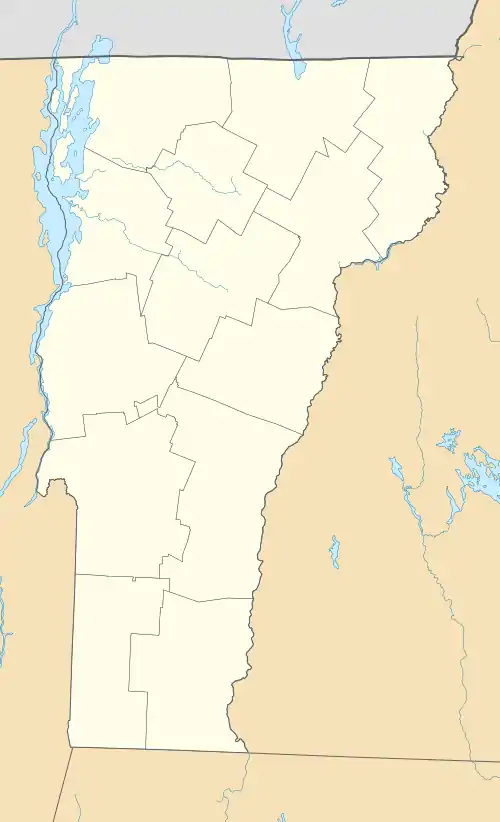Unitarian Universalist Meeting House (Burlington, Vermont) | |
 Unitarian Universalist Meeting House at the top of Church Street | |
  | |
| Location | 152 Pearl Street, Burlington, Vermont |
|---|---|
| Coordinates | 44°28′51.24″N 73°12′46.1″W / 44.4809000°N 73.212806°W |
| Built | 1816 |
| Architect | Peter Banner (with possible assistance from Charles Bulfinch) |
| Architectural style | Federal |
| Part of | Head of Church Street Historic District[1] (ID74000207[2]) |
| Added to NRHP | July 15, 1974 |
Built in 1816,[3] the Unitarian Universalist Meeting House (formerly known as The Brick Meeting House) is the oldest remaining place of worship established by settlers in Burlington, Vermont.[4] It is located along the northern side of the intersection of Pearl Street and the Church Street Marketplace.
The building is a contributing property of the "Head of Church Street" Historic District, in combination with the Masonic Temple (built in 1897) and the Richardson Building. The historic district was added to the National Register of Historic Places on July 15, 1974.[5]
The Unitarian Universalist Meeting House is home to the First Unitarian Universalist Society of Burlington, Vermont, which is a member congregation of the Unitarian Universalist Association and Northern New England District.[6]
History
The Unitarian Society was originally part of the Congregational church that was organized in Burlington, Vermont on February 23, 1805. However, in 1810, the Congregational Society divided into the Trinitarian or Calvinistic Society, which embraced the doctrine of the Trinity, and the Unitarian Society, which rejected it. The Rev. Daniel Haskel was ordained over the Trinitarian society on April 10, 1810, where the Rev. Samuel Clark was ordained over the Unitarian Society on April 19 of that year.
The laying of the cornerstone of the Unitarian church occurred around the 1st of May in 1816, with the remainder of the construction taking about seven months to complete at an approximate cost of $23,000, including the clock, bell, and organ (which was transported from Boston by sleigh). In December of that year, the pews of the lower floor were sold "for upwards of $21,000". The Unitarian Society appointed E.T. Englesby as the superintendent to officiate the completion of the building. The Burlington Northern Sentinel issue of December 27, 1816 described the church as "91 feet in length, 60 in breadth, with a steeple of 170 feet in height". The Church was dedicated on January 9, 1817.[7]
In 1910, prompted by a letter from historical researcher from Boston, the Burlington city treasurer L.C. Grant had discovered that the original bell for the church was cast by Paul Revere on October 13, 1816. The bell weighing 1,286 lb (583 kg), along with its tongue weighing 31 lb (14 kg) was sold to the Town of Burlington for $592.65 (at a cost of $0.45 per pound).[8] The bell was recast in 1828 (at a cost of $166.88),[9] and was replaced sometime in the 1900s after a crack had developed.
In August 1954, the church steeple was struck by lightning that unknowingly caused extensive deterioration over the course of the ensuing sixteen months, until it was revealed that the base had settled and tilted eastward by approximately two feet.[10] By 1956, the decision was made to demolish the steeple, which took about six weeks to complete. Steeplejacks out of Framingham, Massachusetts managed to salvage the windows, bell, and pieces of metal sheathing during the process. A replacement spire was completed and dedicated in September 1958. The presiding pastor of the time, the Rev. Robert S. Miller had commented that the project was financed by a $55,000 fund drive "to which people of nearly all faiths contributed".[11]
Gallery
 Oblique view of the church, 2013
Oblique view of the church, 2013 View of the church from the Church Street Marketplace, 2004
View of the church from the Church Street Marketplace, 2004.jpg.webp) Vintage postcard of the church, circa 1930-45
Vintage postcard of the church, circa 1930-45 Historic wayfinding signage at the Unitarian Church
Historic wayfinding signage at the Unitarian Church
References
- ↑ Stephen J. Raiche (July 15, 1974). "National Register of Historic Places Inventory - Nomination Form: "Head of Church Street" Historic District" (PDF). National Park Service. Retrieved November 25, 2015. 5 Photos (1973)
- ↑ "National Register Information System". National Register of Historic Places. National Park Service. July 9, 2010.
- ↑ UVM Historic Preservation Program, "Early 20th-century Postcard Views" - 152 Pearl Street The Unitarian Church, Portman, Elissa, 2012
- ↑ "The First Unitarian Universalist Society of Burlington, Vermont: Our History". Burlington, Vermont: The First Unitarian Universalist Society of Burlington. Retrieved November 25, 2015.
- ↑ City of Burlington, Vermont: Department of Planning & Zoning - Properties & Districts listed on the National Register, November 2011. http://www.burlingtonvt.gov/PZ/National-Register-of-Historic-Places
- ↑ "The First Unitarian Universalist Society of Burlington, Vermont: Who We Are". Burlington, Vermont: The First Unitarian Universalist Society of Burlington. Retrieved November 26, 2015.
- ↑ "The Semi-Centennial Celebration of the Dedication of the "Brick Meeting House" Of the First Congregational (Unitarian) Society in Burlington". The Daily Free Press, Vol.19, No. 292. No. 6, College St., Burlington, Vermont: G.G. & B.L. Benedict. January 11, 1867.
{{cite news}}: CS1 maint: location (link) - ↑ "Bell From Paul Revere Foundry: Patriot Cast That On Unitarian Church: In 1816 - Original Bill Found Among Archives of the Church - A Discovery of Note". "The Burlington Daily News". March 11, 1910.
- ↑ Heininger, Alfred H. (1945). Unitarianism In Burlington.
- ↑ "Burlington Church Steeple is Doomed". "The Burlington Free Press". December 21, 1955.
- ↑ "At Dedication - New Unitarian Church Steeple Called Symbol of Serenity". "The Burlington Free Press". September 29, 1958.
